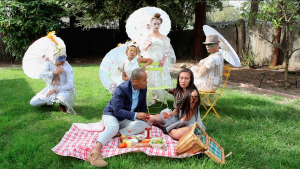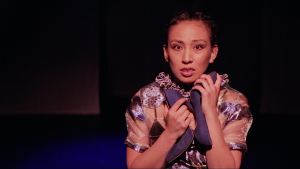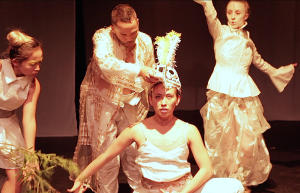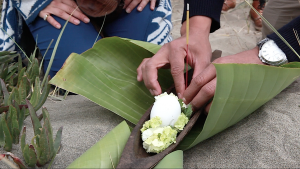The making of ‘She, Who Can See’
SAN FRANCISCO — It was clear in Ocean Beach during sunset. Bai Liza Saway, a Talaandig indigenous leader, walked to shore until waves lapped at her feet. Dressed in traditional garb, a short sleeved mid-riff length top with wrap around skirt decorated with patterns of subtle intricacies in red, white, and black, she bent down, touched the water, and proclaimed, “Madama ko lang ang tubig at makita ko lang ang dagat, ay parang nakauwi na rin ako sa amin” (Just to touch the water and see the ocean, makes me feel like I have come home).
She held a ritual with Filipino American cousins who could see and interact with entities and ancestral spirits. This gift was treated as a burden, even a curse. But the more they tried to shun and bury it under the rubble of modern American life, the more it continued to haunt them through apparitions and possessions by spirits wanting to be acknowledged; ancestral spirits that are legitimate parts of their past and their selves.
Also present were Alleluia Panis, Dianne Que (former Program Manager of Kularts), and myself.
Bai Liza chanted a prayer invoking entities of the earth, wind, water, and fire. An offering of hardboiled eggs, incense, and betel nut on a banana leaf was laid and left out to be consumed by the ocean.
That was the beginning of a ceremony of connecting to ancestors through indigenous ways that supposedly have been eradicated and forgotten. The Talaandig had lost most of their indigenous ways through colonization but they looked into their past and remembered their original selves. Bai Liza Saway had come from the Philippines to share her wisdom and work “based on the understanding of the harmonious relationships of plants, animals, human beings, and spirits.”
Later that evening, a plastic banig, a matt traditionally woven with buri leaves, was laid out on the living room of an apartment in Daly City. On it were candles, areca nut, betel leaves, and lye to make nga-nga, incense, boiled rice, thin strips of white cloth, an empty bowl, and a bolo knife. In the corner were a couple of chickens, one black and the other white, with legs tied together.
As the sky darkened outside, candles and incense were lit for the sacred space. Bai Liza Saway took a betel leaf, smeared it with some lye, and wrapped it around an areca nut while softly chanting. She made a plateful of nga-nga and set it aside. She chanted a prayer and made offerings. The cousins were handed strips of cloth that they tied around their foreheads. The plate of nga-nga was passed and taken as an agent of communion.
As the psychoactive effects kicked in, the cousins were invited to speak: to share their experiences, troubles, and wishes. After they had spoken, Bai Liza acted as a bridge to the spirit world, made their wishes known, and made peace. It culminated with sacrificial offering: the chickens’ throats slit open and their blood drained on the bowl. A final prayer was said, and a blessing for those of us who have gathered.

They appear everywhere.
That was six years ago. Unbeknownst to me then, the creative process was already in motion; that I was already in collaboration with Alleluia Panis on “She, Who Can See.” The experience of the ceremony was inspiring. In fact, one of the cousins became one of Alleluia’s models for Salima’s character, a fourth-generation Filipina American who sees ancestral entities in her dreams and just about everywhere else.
In making the film for the production, I drew on my personal experiences of seeing through altered states of consciousness, dreams, imagination, and intuition. In essence, seeing is the perception of our surroundings through inward projections: the outside world projected onto the mind.
On the other hand, cinema is an outward projection: from a movie projector or a file to a screen. It is no accident that parts of a camera are analogous to the human eye as well as the acquisition of images: through the lens then recorded onto celluloid or a memory card. The memories/images are then projected onto a screen to be seen.
This outward projection of a subjective point of view becomes universal when experienced in reverse when the movie is being watched inside a theater, and ultimately in the mind.

Alexandria Diaz De Fato as Salima.
Yet things need not be physically there to be seen. For example, a vacation starts as a concept, seen in the mind like how we foresee the future. It is the same in reverse: seeing/reliving the past – vivid and resonates exponentially influencing the future. This way of experiencing is at the essence of “She, Who Can See.” Through the point of view of Salima’s character, cinema becomes a mirror of the mind. The audience experiences what the character goes through. They are inside Salima’s head experiencing her self-discovery and acceptance of who she is.
The odyssey in the creation of “She, Who Can See,” was cathartic/transformative for me since I went through (and still am) the process of reclaiming a pre-colonized self. It was a process of healing the schizophrenic effects of post-colonial hybridity. I acknowledged and embraced my indigenous past and integrated it with my postcolonial present as I move forward into the future. In essence, Salima is I as well as you. “She, Who Can See,” is ceremony. It is healing as the waters from where it was conceived many sunsets ago.
After a successful run in May 2015, “She, Who Can See” is back on September 4, 5, 11, and 12, , Fridays and Saturdays, with two shows each day at 7 p.m. and 9 p.m. at Bindlestiff Studio in San Francisco.
Tickets are available in advance at: shewhocansee.bpt.me For more information visit: www.kularts.org
Wilfred Galila explores and exploits various media for making art and telling stories. As a photographer, graphic artist, and filmmaker, he is the lead artist for “Kodakan, Pilipinos in the City,” a photo and video exhibit that contextualizes the Filipino-American narrative and examines perceptions of who/what is a Filipino, and a collaborator for the multimedia dance theater production, “She, Who Can See.”
Like us on Facebook

